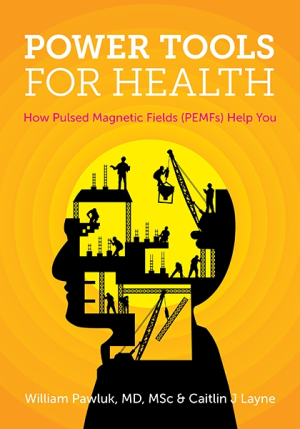Power Tools for Health
How Pulsed Magnetic Fields (PEMFs) Help You
Power Tools for Health is highly recommended for those seeking alternatives to traditional medical treatments.
William Pawluk and Caitlin Layne’s Power Tools for Health is an exhaustively researched overview of pulsed electromagnetic field (PEMF) therapy. It balances its ideological argument with a practical guide.
The book is intuitively structured and broken into five sections. The first contains background on magnetic fields and an overview of how PEMFs work; the second looks at the ways PEMFs physically affect the body.
The next section applies that discussion to a list of health conditions, including addiction, cancer, and wounds. The final two sections are a helpful guide for researching, purchasing, and using a PEMF system. They are designed to fit any budget, lifestyle, and health concern.
The book is careful not to claim that PEMF therapy is a miracle cure; instead, it examines how the approach works with other therapies, reduces the risk of common side effects, and helps prevent or mitigate a range of health concerns.
The writing is endearingly grounded and personal. In the introduction, Pawluk discusses how he faced ridicule and censure in the medical community for pursuing his research. While alternative therapies can often cause initial skepticism, the book confidently dispels any lingering doubts about the effectiveness of PEMF by explaining each of its points in full, often with clear illustrations.
Each example shows how the system works against a specific health concern, what it does physiologically, and how it can work in conjunction with other therapies. Specific PEMF devices are discussed to help the reader navigate the marketplace, but it never feels like a sales pitch, and care is taken to provide both the benefits and drawbacks of each product. The result is balanced, objective, and helpful.
The book is professionally presented and surprisingly approachable for such a dense topic. Some sections, like a discussion of the therapy’s physiological effects, are understandably technical, but background information is provided when needed and the introduction to the science of the machines is practical and clear. A massive list of over five hundred reference sources provides avenues for further research. The tone fits the topic throughout, even if in some places the writing is bogged down by the level of detail and can be a little dry.
Power Tools for Health may not appeal to those married to Western medicine, but for readers with an open mind, there is a great deal to learn here. It is highly recommended for those seeking alternatives to traditional treatments or anyone looking to broaden their understanding of new therapies.
Reviewed by
Sarah Stewart
Disclosure: This article is not an endorsement, but a review. The publisher of this book provided free copies of the book and paid a small fee to have their book reviewed by a professional reviewer. Foreword Reviews and Clarion Reviews make no guarantee that the publisher will receive a positive review. Foreword Magazine, Inc. is disclosing this in accordance with the Federal Trade Commission’s 16 CFR, Part 255.

